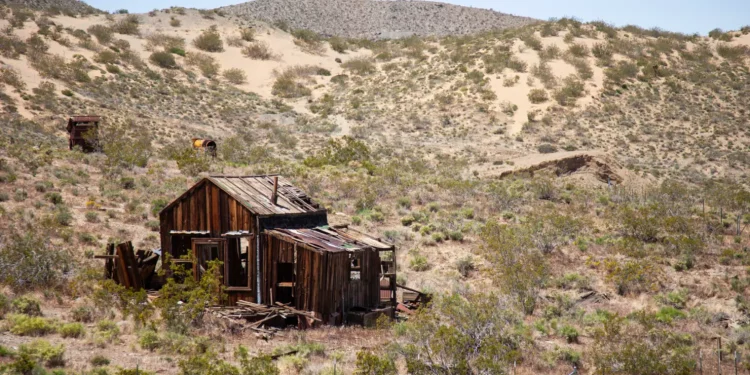The allure of abandoned places is undeniable. They stand as silent testaments to a bygone era, whispering tales of a time that has passed. From deserted military bases to forgotten mining towns, these remnants of the past hold a unique charm, a melancholic beauty that beckons the curious and the adventurous. Today, we journey to a place swallowed by time, a forgotten treasure hidden amongst the rolling hills of Missouri: Arlington, a ghost town that once thrived along the legendary Route 66.
The Heyday of Arlington
This Article Includes
Nestled along the banks of the scenic Gasconade River in Phelps County, Missouri, Arlington was established in 1867. Initially a small farming community, Arlington’s fortunes changed dramatically with the arrival of the St. Louis & San Francisco Railway in the late 1880s. The train brought with it an influx of visitors seeking respite from the hustle and bustle of city life. Capitalizing on its natural beauty and proximity to the Gasconade River, Arlington soon transformed into a popular resort town.
Hotels and boarding houses sprung up to accommodate the growing number of tourists. General stores stocked provisions for visitors, while saloons and restaurants provided entertainment and refreshment. Life in Arlington revolved around the river. Boating, fishing, and swimming were popular pastimes, and the town even boasted a bathhouse for those seeking a refreshing dip in the cool waters of the Gasconade.
The arrival of Route 66 in the 1920s further solidified Arlington’s position as a thriving tourist destination. Route 66, also known as the “Mother Road,” became a national artery, connecting Chicago to Los Angeles and attracting countless travelers seeking adventure and escape. Arlington, with its picturesque location and convenient amenities, became a welcome stopover for weary travelers. Gas stations, diners, and souvenir shops lined the highway, catering to the needs of the Route 66 crowd.
The Decline of Arlington
The prosperity of Arlington, however, was not destined to last. The construction of Interstate 44 in the late 1950s marked a turning point. Designed for speed and efficiency, Interstate 44 bypassed towns like Arlington, effectively draining them of their lifeblood – Route 66 traffic. As travelers shifted to the faster interstate, businesses along Route 66 began to suffer. Arlington was no exception.
With fewer visitors stopping by, businesses in Arlington started to struggle. One by one, shops closed their doors, and hotels stood empty. The once-bustling town slowly began to resemble a deserted movie set. The exodus of businesses led to a decline in population. Residents, with limited economic opportunities, started moving away in search of work elsewhere.
By the late 1960s, Arlington was a shell of its former self. The last remaining businesses had closed, and the once-vibrant community became a ghost town. Nature slowly began to reclaim its dominion. Buildings, once filled with laughter and activity, became silent sentinels, their windows like vacant eyes staring out at the passing world. Vegetation crept up the walls, and the relentless march of time began to etch its mark on Arlington’s once-proud structures.
Arlington Today: A Glimpse into the Past
Despite its deserted state, Arlington holds a unique appeal in the present day. For urban explorers and photographers, the abandoned town offers a glimpse into a bygone era. The remnants of shops, their faded signs still clinging to the weathered facades, tell stories of forgotten dreams and simpler times. Nature’s artistry is on display, with vines crawling through windows and trees pushing their way through cracked pavement. Photography enthusiasts find inspiration in the town’s haunting beauty, capturing the essence of decay and the passage of time.
While Arlington’s future remains uncertain, efforts are underway to preserve its remnants and acknowledge its historical significance. Local historical societies and Route 66 enthusiasts recognize the value of Arlington as a tangible link to Missouri’s past and the history of Route 66. Efforts are being made to document the town’s history and identify potential ways to preserve its remaining structures. Some even envision the possibility of a partial revitalization, transforming Arlington into a historical site or a living museum that showcases the forgotten era of Route 66.
Conclusion
Arlington, Missouri, stands as a poignant reminder of the ephemeral nature of prosperity. Once a bustling town teeming with life, it now serves as a silent testament to the shifting tides of progress. Yet, in its abandonment, Arlington offers a unique opportunity to connect with the past and appreciate the power of history. Its story reminds us of the importance of remembering forgotten places and the lessons they hold.
The state of Missouri is dotted with numerous ghost towns like Arlington, each with its own unique story to tell. From mining towns ravaged by resource depletion to railroad settlements bypassed by progress, these abandoned communities offer a glimpse into the diverse history of the state. Exploring these ghost towns can be a rewarding experience, allowing us to connect with the past, appreciate the ingenuity and resilience of our ancestors, and contemplate the ever-changing landscape of human settlement.
So, the next time you find yourself in Missouri, consider venturing off the beaten path and exploring one of its many forgotten towns. You might just stumble upon a hidden gem, a silent storyteller waiting to unveil its secrets.










